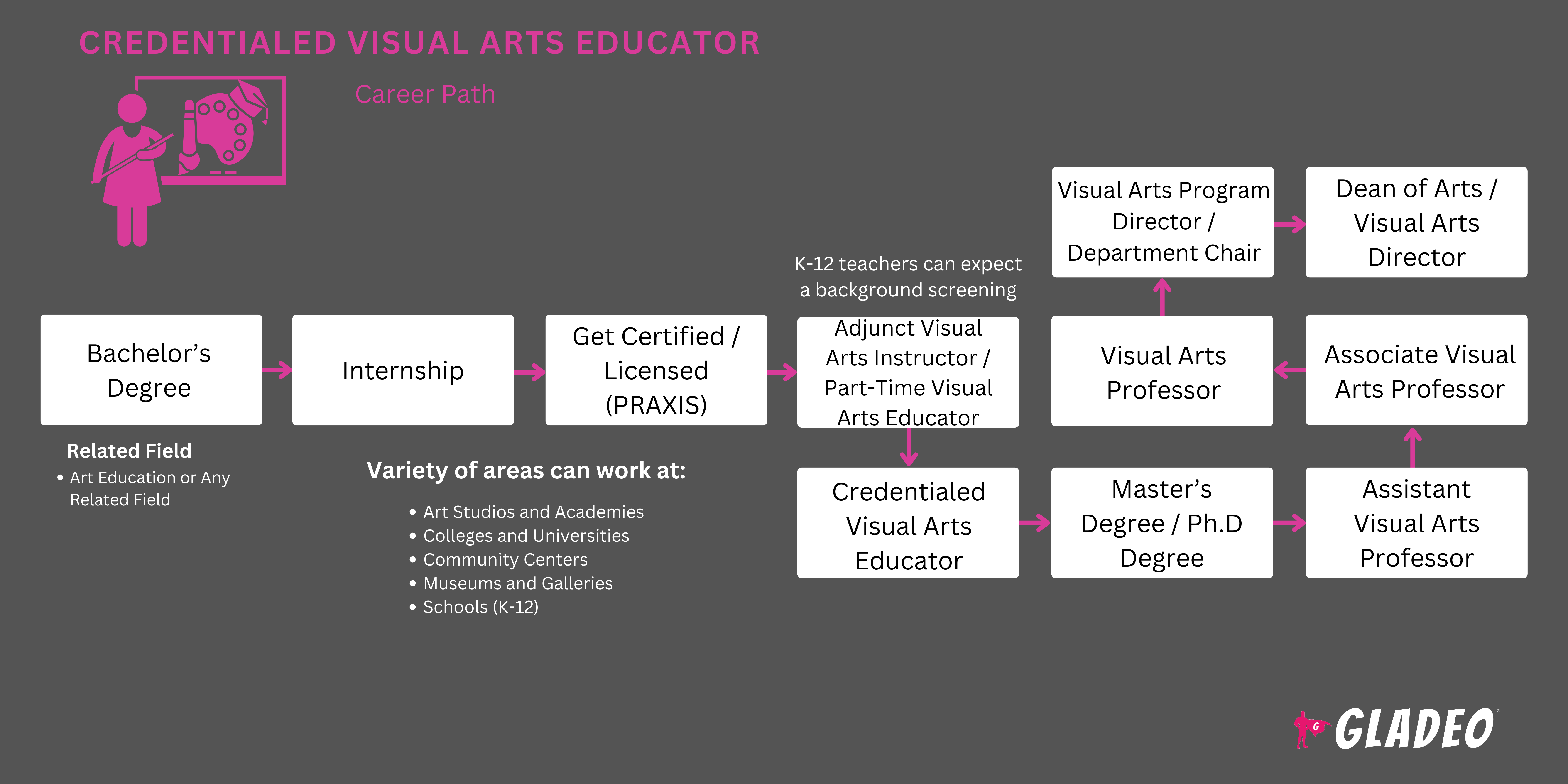Mga spotlight
Sertipikadong Guro ng Sining, Instruktor ng Sining Biswal, Lisensyadong Tagapagturo ng Sining, Propesyonal na Tagapagturo ng Sining, Akreditadong Guro ng Sining, Kredensyal na Instruktor ng Sining, Tagapagdaloy ng Sining Biswal, Sertipikadong Tagapagturo ng Fine Arts, Lisensyadong Guro ng Sining Biswal, Kwalipikadong Tagapagturo ng Sining
Kinatatakutan ng mga estudyante ang ilang klase, ngunit ang isang klase na karaniwang minamahal ng lahat ay ang Sining! Iniulat ng mga Tagapagturo ng Sining ang mataas na kasiyahan sa trabaho dahil nasisiyahan sila sa pagtuturo ng isang asignaturang gustong matutunan ng mga estudyante. Mas kaunting stress at mas maraming pagkamalikhain para sa lahat ng kasangkot. Ang ilang klase sa sining ay tumatalakay sa akademikong aspeto, tulad ng kasaysayan ng sining, ngunit karamihan ay isinasali ang mga silid-aralan sa pamamagitan ng praktikal na pagsasanay.
Hindi tulad ng mga karaniwang asignaturang itinuturo sa mga paaralang K-12, tulad ng matematika, Ingles, o agham, mas kakaunti ang pormal na mga tuntunin o pormula pagdating sa pagtuturo ng sining. Sa halip, tinutulungan ng mga Art Educator ang mga mag-aaral na matuklasan ang mga konsepto at pamamaraan para sa paglikha ng mga biswal na likhang sining, ipinapakita sa kanila kung paano gamitin ang mga materyales at kagamitan sa hanapbuhay habang hinihikayat silang galugarin ang mga ideya. Lapis, tinta, pintura, o kahit potograpiya man ang midyum nito, dapat maging masigasig ang mga Art Educator tungkol sa paksa at maipamahagi ang hilig na iyon. Responsibilidad din nila ang pagtatanim ng wastong pag-unawa sa mga kulay, komposisyon, estilo, at iba pang mahahalagang bagay na may kaugnayan sa produksyon ng sining.
- Ang pagtatrabaho sa isang larangan na tunay na minamahal ng karamihan sa mga guro (at mga estudyante)
- Pagtulong sa mga mag-aaral na matuklasan ang mga nakatagong talento
- Pagmamasid sa mga mag-aaral na umuunlad bilang mga baguhang artista
- Nagbibigay-daan sa mga positibong kapaligiran sa pag-aaral kung saan maaaring magrelaks at maipahayag ng mga mag-aaral ang kanilang mga sarili, na mabuti para sa kalusugang pangkaisipan
- Pag-aambag sa kinabukasan ng mas malawak na mundo ng sining
Iskedyul ng Paggawa
- Ang mga Tagapagturo ng Sining ay nagtatrabaho nang full-time sa mga regular na oras ng pasukan. Tulad ng anumang trabaho sa pagtuturo, maaaring may mga trabaho pagkatapos ng oras ng klase na kinakailangan upang maghanda ng mga aralin o magbigay ng mga takdang-aralin. Ang mga guro ng K-12 ay maaaring asahan ang mga off-time ayon sa akademikong kalendaryo ng mga pista opisyal at pahinga.
Mga Karaniwang Tungkulin
- Maghanda ng mga nakakaengganyong pang-araw-araw na aralin at mga aktibidad sa silid-aralan
- Suriin ang kasaysayan ng sining upang talakayin ang mga sikat at mahahalagang likhang sining at iba't ibang istilo
- Suriin ang mga elementong nauugnay sa paglikha ng sining biswal, tulad ng mga linya, 2-D na hugis, tekstura, 3-D na anyo (ibig sabihin, ang volume ng taas, lapad, at lalim), espasyo (perspektibo), mga gulong ng kulay, at halaga (ibig sabihin, mga tono ng kaliwanagan o kadiliman)
- Magtalaga ng mga proyekto sa sining at repasuhin ang mga tagubilin kasama ang mga mag-aaral
- Turuan ang wastong paggamit ng mga naaangkop na tool at materyales para sa mga partikular na proyekto
- Gabayan ang mga mag-aaral sa kanilang mga malikhaing paglalakbay habang ginalugad nila ang kanilang sariling mga istilo
- Mag-set up ng mga collaborative na proyekto na nagbibigay-daan sa mga grupo na magtulungan
- Magtalaga at mag-proctor ng mga pagsusulit at pagsusulit; magbigay ng marka sa mga takdang-aralin at mag-alok ng feedback
- Ipakita ang ligtas na paggamit ng mga mapanganib o nakalalasong kagamitan sa sining, tulad ng pandikit, pampawi ng pintura, gunting, atbp.
Mga Karagdagang Pananagutan
- Tulungan ang mga mag-aaral na nahaharap sa mga kahirapan o hamon sa pagkatuto
- Hikayatin at hikayatin ang mga mag-aaral na ipahayag ang kanilang mga sarili nang naaayon
- Ibahagi ang mga ideya sa kurikulum sa pamunuan at mga guro ng paaralan
- Ituro sa mga mag-aaral ang pangangailangang pangalagaan nang mabuti ang kanilang mga kagamitan at materyales (na maaaring magastos)
- Ipakita sa mga klase kung paano panatilihing malinis at organisado ang mga lugar ng trabaho
Soft Skills
- Pagnanais at kakayahan na tulungan ang iba na magtagumpay
- Empatiya at pasensya
- Kasiglahan
- May kaalamang panlipunan at kultural na kamalayan
- Matalas na kasanayan sa organisasyon
- Hindi mapanghusgang pamamaraan sa pagtuturo
- Pagkamaparaan
- Mga kasanayan para sa koordinasyon at pagtuturo ng mga aktibidad
- Malakas na kasanayan sa komunikasyon
- Kakayahang subaybayan at suriin ang kilos ng mga mag-aaral
Mga Kasanayang Teknikal
- Kaalaman sa kasaysayan ng sining at mga elemento ng paglikha ng biswal na sining
- Pamilyar sa lahat ng naaangkop na kagamitan at kagamitan na may kaugnayan sa antas na itinuturo
- Maaaring kabilang sa mga kagamitan sa sining at craft ang: iba't ibang timbang at uri ng papel, canvas, krayola, pastel, uling, marker, graphite drawing pencils, sharpeners, colored pencils, ink pens, paintbrush, trays, thinners, acrylic paint, oil paint, watercolors, tempera, sponges, glue, glue sticks, pom, string na pangkola, stick ng goma, pastel, string na pangkola. sinulid, felt, gunting, ruler, pambura, tape, felt, guwantes, at panlinis ng kamay
- Pamilyar sa mga kagamitan sa presentasyon sa silid-aralan (tulad ng mga video magnifier, telebisyon, atbp.)
- Kaalaman sa mga printer, scanner, at kagamitan sa photocopy
- Microsoft Office, Google apps, Macintosh software
- Paggamit ng mga sistema ng database ng paaralan
- Pamilyar sa software na pang-edukasyon na idinisenyo para sa mga mag-aaral ng K-12
- Mga pampubliko at pribadong paaralan ng K-12
- Mga paaralang charter
- Mga institusyong pang-edukasyon pagkatapos ng sekondarya (mga kolehiyo sa komunidad, mga unibersidad)
- Mga sentro ng kabataan at mga daycare
Ang mga Tagapagturo ng Sining ay may mahalagang papel sa mahusay na panlipunan at emosyonal na pag-unlad ng mga mag-aaral, mula sa maagang pagkabata hanggang sa hayskul at sa mga susunod pang taon. Tinutulungan nila ang pag-integrate o pagpapalago ng mga malikhaing kasanayan at kakayahan na magagamit ng mga mag-aaral sa buong buhay nila, anuman ang kanilang mga propesyon o mga pagpipilian sa buhay sa hinaharap. Maaaring mahirap sukatin ang mga nasasalat na benepisyong nakukuha ng mga kabataan mula sa pag-aaral at paglikha ng sining. Dahil dito, ang ilang mga guro (at mga magulang) ay maaaring hindi lubos na nauunawaan ang kahalagahan ng mga aralin sa sining para sa mga mag-aaral sa lahat ng edad. Gayunpaman, ang mga Tagapagturo ng Sining ay dapat manatiling positibo at magpatuloy, tiwala sa kaalaman na ang kanilang trabaho ay may malaki, pangmatagalang (at kung minsan ay nagbabago ng buhay) na epekto sa buhay ng bawat mag-aaral na kanilang tinuturuan!
Maaaring makaranas paminsan-minsan ng pagkadismaya ang mga Tagapagturo ng Sining kung ang kanilang mga kapantay sa STEM (Science, Technology, Engineering, and Mathematics) ay mas nakakakuha ng atensyon. Gayunpaman, nasaksihan ng mga nakaraang taon ang ebolusyon ng STEM patungong STEAM (Science, Technology, Engineering, Arts and Math) habang nauunawaan ng mga mundo ng akademya at negosyo ang mahalagang papel na ginagampanan ng sining at pagkamalikhain sa pag-unlad ng mga inobasyon sa STEM.
Kamakailan lamang, nakita ang pagtaas ng paggamit ng teknolohiya sa silid-aralan at ang pagtaas ng distance learning kung naaangkop para sa kaligtasan ng mga estudyante. Kinailangang manatiling flexible ang mga Art Educator at makiisa sa mga pagbabagong ito, ginagamit ang mga ito upang isulong ang paglikha ng sining sa mga kapana-panabik na bagong paraan (tulad ng paggawa ng kontemporaryong digital art). Sa katunayan, binabago ng digital art ang eksena ng sining nitong mga nakaraang taon, at nakapasok na sa mga museo sa buong mundo!
Gaya ng nahulaan mo na ngayon, karamihan sa mga Tagapagturo ng Sining ay mahilig lumikha ng sining noong bata pa sila. Marami ang may maagang kakayahan sa pagguhit o pagpipinta; ang iba ay maaaring natuklasan ang sining noong kanilang mga tinedyer bilang isang paraan ng pagpapahayag ng kanilang mga ideya, panloob na mga kaisipan, at paminsan-minsang mga kaguluhan. Bagama't mayroong estereotipo tungkol sa "hindi mapakali" na artista, maraming artista ang hindi lamang masaya at kuntento kundi masigasig din sa pagbabahagi ng kanilang sigasig sa iba. Ang pagnanais na magturo ay isa ring katangian na maaaring nalinang nang maaga, marahil sa pamamagitan ng pagtulong sa mga nakababatang kapatid o mga kaklase.
- Tulad ng karamihan sa mga guro, ang mga Art Educator ay nangangailangan ng bachelor's degree na may minimum na GPA sa isang kaugnay na major, tulad ng Art Education.
- Dapat kumpletuhin ng mga estudyante ang isang programa sa paghahanda para sa guro bilang bahagi ng kanilang degree
- Karamihan sa mga programa sa paghahanda sa pagtuturo ay nagsasama ng isang internship upang magbigay ng oras ng pagsasanay sa pagtuturo sa mga mag-aaral sa baitang na gusto mong ituro.
- Karaniwang nangyayari ang internship pagkatapos ng iyong unang dalawang taon sa kolehiyo
- Ang mga mag-aaral ay nagtatrabaho sa ilalim ng gabay ng isang sinanay na guro, na magsasagawa ng mga obserbasyon at magbibigay ng feedback sa iyong kahusayan sa pagtuturo.
- Pagkatapos makumpleto ang mga kinakailangan sa edukasyon, malamang na kakailanganin mo ng lisensya o sertipikasyon mula sa estado. Sa parehong mga kaso, kinakailangan na makapasa sa isang pagsusulit na inaprubahan ng estado.
- Tandaan, ang mga kinakailangan ay nag-iiba ayon sa estado at uri ng paaralan (pampubliko laban sa pribado)
- Ang mga nagtapos nang hindi kumukuha ng programang paghahanda sa pagtuturo ay maaaring makakuha ng karanasan sa pamamagitan ng alternatibong sertipikasyon
- Ang American Board for the Certification of Teacher Excellence ay nag-aalok ng mga mapagkukunan tungkol sa alternatibong sertipikasyon
- Maaari mo ring tingnan ang Alternatibong Gabay sa Sertipikasyon ng Guro para sa Teacher Certification Degree para sa kumpletong paggalugad sa paksang ito.
- Karamihan sa mga estado ay hinihiling sa mga guro na pumasa sa isang pagsusulit na Praxis. Maaaring kabilang dito ang isang Core Academic Skills for Educators o isang Praxis Subject Assessment lamang na may kaugnayan sa sining.
- Dapat asahan ng mga guro ang isang background screening bago ang pagkuha ng lisensya, na titingnan ang kriminal na kasaysayan at posibleng credit history.
- Mas gusto ng ilang estado o employer na ang mga guro ay kumuha ng master's degree sa isang punto
- Kabilang sa iba pang mga kinakailangan ang:
- Kamalayan at pangako sa pagkakaiba-iba at pagkakapantay-pantay sa mga paaralan
- Pamilyar sa mga kompyuter, tablet, software sa opisina, at mga kapaligiran sa pag-aaral na nakabase sa Internet
- Pamilyaridad sa pangalawang wika sa ilang paaralan
- Mga karagdagang pagsusulit sa kasanayan, kung nakikipagtulungan sa mga kabataang may espesyal na pangangailangan
- Dapat mong tiyakin na ang iyong paaralan ay akreditado sa rehiyon at ang iyong programa ay akreditado rin ng isang naaangkop na institusyon.
- Karamihan sa mga estado ay hindi magbibigay ng lisensya o sertipikasyon kung ang iyong degree ay hindi mula sa isang paaralang akreditado ng rehiyon at isang programang akreditado ng National Council for Accreditation of Teacher Education (NCATE) o ng Council for the Accreditation of Educator Preparation (CAEP).
- Palaging ihambing ang mga gastos sa matrikula, silid at pagkain, at mga pagkakataon sa scholarship (bilang karagdagan sa pederal na tulong pinansyal para sa mga estudyante)
- Magpasya kung alin ang pinakamainam para sa iyo, isang tradisyonal na karanasan sa loob ng kampus, mga online na kurso, o isang hybrid na programa
- Bigyang-pansin ang anumang mga kinakailangan sa personal na pag-aaral kapag nag-sign up para sa isang online degree. Tiyak na hindi mo gugustuhing magkaroon ng anumang sorpresa pagkatapos mong mag-enroll!
- Maghanap ng mga programang naglalathala ng mga istatistika ng pagtatapos at pagkakalagay sa trabaho. Maraming paaralan ang nagsisilbing mga pipeline para sa mga lokal na employer na pinapanatili nilang matibay ang ugnayan sa mga ito.
- Sapat nang sabihin, kumuha ng maraming kurso sa sining!
- Kailangan din ng mga Tagapagturo ng Sining ang mga kasanayan sa pasulat at pasalitang komunikasyon, pamumuno, pamamahala ng proyekto, at pedagohiya sa pagtuturo.
- Magboluntaryo sa inyong paaralan upang tumulong sa mga proyektong nagpapaunlad ng kakayahan sa pamumuno at pamamahala ng proyekto
- Kumuha ng mga kurso upang matulungan kang maghanda para sa pagtuturo sa silid-aralan sa totoong mundo, tulad ng pagsasalita sa publiko, sikolohiya, espesyal na edukasyon, at pamamahala ng pag-uugali
- Maghanap ng mga pagkakataong bayaran o magboluntaryo sa labas ng paaralan, tulad ng pagtatrabaho para sa mga organisasyon ng kabataan, mga sentrong pangrelihiyon, o mga sentro ng pangangalaga sa bata
- Alamin ang tungkol sa kasalukuyang pagkakaiba-iba at mga pamantayang panlipunan sa mga setting ng K-12
- Matutong ipahayag ang iyong sarili nang maigsi at malinaw. Maging komportable sa iyong sarili upang maging komportable ang mga mag-aaral sa malikhaing kapaligiran sa pagkatuto na iyong binuo para sa kanila!

- Tapusin ang lahat ng iyong mga kinakailangan sa edukasyon at paghahanda, kabilang ang anumang lisensya o sertipikasyon na kinakailangan ng estado, mga pagsusulit sa Praxis, atbp.
- Ilista ang lahat ng iyong trabaho, edukasyon, at mga ekstrakurikular na aktibidad sa iyong resume, na dapat ay lubos na pinakintab at na-edit.
- Gumamit ng mga resultang maaaring masukat kung maaari, tulad ng mga istatistika sa matagumpay na mga resulta at bilang ng mga mag-aaral na iyong nakatrabaho
- Manatiling nakikipag-ugnayan sa iyong mga dating superbisor at guro, kasama na ang iyong internship mentor. Ang mga indibidwal na ito ay maaaring magsilbing napakahalagang sanggunian pagdating ng panahon.
- Mag-set up ng mga alerto sa abiso ng trabaho sa Indeed.com, EdJoin.org, at iba pang mga portal ng trabaho at subaybayan ang mga deadline ng aplikasyon
- Basahing mabuti ang mga post ng trabaho at siguraduhing isama ang mga kaugnay na keyword sa iyong resume
- Magpakita ng kamalayan at kahusayan na may kaugnayan sa eLearning at iba pang mga uso
- Alamin ang iyong mga terminolohiya kapag oras na para sa interbyu. Manatiling updated sa mga bagong pag-unlad sa Edukasyon sa Sining
- Iparamdam ang iyong sigasig sa pagtuturo ng sining! Huwag matakot na tunay na ipakita ang iyong pagkahilig sa trabaho. Gusto ng mga employer na makita ang ebidensya ng iyong mga soft skills pati na rin ang mga kwalipikasyon sa akademiko.
- Kunin ang iyong master's degree, o kumpletuhin ang karagdagang pagsasanay/mga advanced na sertipikasyon
- Magpakita ng taos-pusong pagmamalasakit sa pag-unlad ng edukasyon ng mga bata sa sining
- Galugarin ang mga oportunidad na lampas sa iyong kasalukuyang trabaho at maging sa labas ng estado, kung kinakailangan upang lumago
- Buuin ang iyong reputasyon bilang isang pinuno sa silid-aralan na may mahusay na kasanayan sa pamamahala
- Magpayong sa iba kung kaya mo, at mag-alok ng tulong sa mga estudyante sa kolehiyo na gumagawa ng kanilang mga internship
- Makilahok sa mga aktibidad ng propesyonal na organisasyon (tingnan ang aming listahan ng mga Inirerekomendang Website sa ibaba)
- Maglingkod sa mga komite ng paaralan at distrito na kilala sa lahat; bumuo ng magandang ugnayan sa mga kawani, kapantay, magulang, at administrador
- Maging tagapagtaguyod ng mga karapatan ng mga estudyante
- Panatilihing motibado ang mga mag-aaral sa pamamagitan ng pagsasama ng mga bagong ideya, pamamaraan, at teknolohiya
- Magbasa ng mga libro, magrebyu ng mga mapagkukunan sa website, manood ng mga video para makakuha ng mga bagong ideya, at panatilihing sariwa, masaya, at may makabagong pananaw ang iyong mga silid-aralan!
Mga website
- American Federation of Teachers
- Pedagohiya ng Sining
- Art Rabbit
- Pabrika ng Sining
- Napakalaki
- Felt Tip Pen
- Sining at Kultura ng Google
- Pambansang Asosasyon ng Edukasyon sa Sining
- National Education Association
- Pambansang Samahan ng Magulang na Guro
- Tate Kids
- Ang Guro ng Sining
- Ang Guro sa Sining (YouTube channel)
Mga libro
- Ang Gabay sa Kaligtasan ng Guro sa Sining para sa mga Paaralang Sekundarya: Baitang 7-12, ni Helen D. Hume
- Ang Aklat ng mga Listahan ng Guro sa Sining, ni Helen D. Hume
- Limampung Aralin sa Sining para sa K-12: Edisyong Itim at Puti: Malikhaing Pagkakaiba-iba ng mga Paggalugad sa Sining, ni Eric Gibbons
- Pamamahala ng Silid-aralan para sa mga Guro ng Sining, Musika, at PE, ni Michael Linsin
Kung hindi mo hilig ang maging isang Art Educator, ngunit interesado ka pa ring magsimula ng isang matagumpay na karera sa sektor ng edukasyon, ang Bureau of Labor Statistics ay naglilista ng maraming "Plan B" na mga pagkakataon na maaaring isaalang-alang! Narito ang ilan lamang:
- Mga Guro ng ESL
- Mga Guro sa Karera
- Mga Principal ng Paaralan
- Mga Guro sa Kindergarten at Elementary School
- Mga Guro sa Middle School/Mga Guro sa Postecondary
- Mga Tagapayo sa Paaralan at Karera
- Mga Guro sa Espesyal na Edukasyon
- Mga Katulong ng Guro
Newsfeed

Mga Tampok na Trabaho

Mga Online na Kurso at Tool

Mga Inaasahan sa Taunang Sahod
Nagsisimula ang mga bagong manggagawa sa paligid ng $0K. Ang median na suweldo ay $100K bawat taon. Maaaring kumita ng humigit-kumulang $0K ang mga may karanasang manggagawa.





